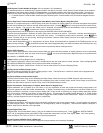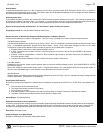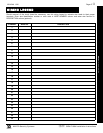
X GEM-P1664 Installation Instructions
L NAPCO Security Systems
WI1424A 1/06
Page 42
Swinger Shutdown:
Swinger Shutdown is a common term used in the burglary alarm industry. It is a feature of an alarm panel that prevents multiple false
alarms from being generated from faulty detectors (or wiring) by limiting the number of alarms a zone may report during a single arm-
ing period. NAPCO has this programmable-by-zone feature named Swinger Shutdown, and has been available on its panels for
years. The SIA False Alarm Reduction standard CP-01 (to which the panel complies) requires the SIA definition of "swinger shut-
down" on all non-fire zones. Our programmable feature allows three trips per arming period which is unacceptable in CP-01 installa-
tions. Therefore, to reduce confusion, the following defines both definitions of "Swinger Shutdown", namely (1) the NAPCO Pro-
gramming Feature and (2) the CP-01 Requirement:
• Swinger Shutdown (NAPCO Programming Feature): Program a zone with this feature to allow only three alarms per arming
period. Auto-Reset must also be programmed for the zone for this feature to work. Enable 2 Count Swinger Shutdown:
Same as Swinger Shutdown (NAPCO Programming Feature) above, but enables two alarms per arming period instead of three.
• Swinger Shutdown (CP-01 Requirement): To meet CP-01, all non-fire zones must not be programmed for Auto-Reset. A
zone not programmed for Auto-Reset will trip only one alarm per arming period. The panel leaves the factory with no zones pro-
grammed for Auto-Reset. If "Enable CP-01 Features" is selected in the Easy Programming menu, all non-fire zones will not be
programmed for Auto-Reset.
System Troubles (Global and Area); Wireless Low Battery; Wireless Supervisory
System troubles may be programmed to report to any telephone number and/or activate any output. Also program Subscriber ID
Numbers, Telephone Numbers, and Report Codes for each system trouble.
Tamper; EZM Tamper; Keypad Tamper; RF Tamper; Wireless Tamper
Removing the cover of an expansion zone module will cause the sounder to pulse and the "
SYS/TRBL" reminder to flash. The keypad
will display "
SYSTEM TROUBLE/E13-NN SERVICE", where "NN" denotes the module number. Press the C button to silence the
sounder ("
SYSTEM READY" will display). Correct the problem, then select RESET SYSTEM TBL to manually reset the system trouble
display. Removing a keypad from the wall causes a similar system trouble indication. The keypad will display "
SYSTEM TROUBLE/E11-
NN SERVICE
", where "NN" denotes the keypad number. Press the C button to silence the sounder ("SYSTEM READY" will display).
To manually reset the system trouble, correct the problem then select RESET SYSTEM TBL.
Note: If either of the tamper conditions is not corrected within 5 minutes, the system trouble will again display at the keypad. A
Tamper condition can be programmed to activate the burglary output and/or report using its associated system Report Code. In
wireless installations, when displaying rf transmitter status, a "Tamper" indication denotes that the transmitter case is open. Note:
The GEM-RP1CAe2/ GEM-K1CA tamper is enabled by cutting jumper JP1 in the keypad.
TCP/IP Communications See Enable TCP/IP Communications
Telco Fail See Enable Line-Fault Test
Telco Line Test Delay See Enable Telephone Line-Fault Test; Time Selection
Telephone Numbers
To report to a central station, Telephone Number 1 must be programmed. Telephone Number 2 is programmed for Backup
Reporting; Telephone Number 3 is programmed for Double or Split Reporting by selecting "Report Event Telco 3" and "Report
Restore Telco 3" in SYSTEM OPTIONS and ZONE OPTIONS.
Private telephone systems may require a Dial-Tone Detection "E" or Pre-Dial Delay "D", followed by an access number to obtain an
outside line. (See Access Number for Outside Line).
It should be noted here that the telephone number need not actually start in the first location shown, and may not end in the last.
Extra locations have been provided to allow for one or more prefix digits: a Pre-Dial Delay "D" or a Dial-Tone Detection "E". What is
important is that the telephone number, with its associated Pre-Dial Delay, Access Number, and Dial-Tone Detection, be wholly
contained within that group of locations, and that they be in their proper sequence. Note: In UL Installations, do not program more
than one "D" before the telephone number.
Temperature Display at Keypad: (Not evaluated by UL)
See the GEM-P1664 Programming Instructions WI1422 or WI1423 for more information. The temperature is displayed instead of the
date on line 2 of the GEM-RP1CAe2 keypad. The keypad will display from –22F to 140F (or -30C to 60C). Fahrenheit is the default
setting, select Celsius by enabling address 1668 option 2. When this Temperature Display Option is enabled, Zone 6 becomes the
input for the “Napco Temperature Sensor” module and Zone 6 of the panel becomes inoperative; if Zone Doubling is selected, zones
6, 14 will be inoperative.
Address 1668 option 3 enables Zone 6 to report a temperature problem. Address 1666 (options 1-7) set the lower limit temperature
value and address 1667 (options 1-7) sets the upper limit temperature value (both values are set in binary). If the temperature de-
tected by the panel is above or below these set limits, the panel will report an alarm on Zone 6. To function and report properly, Zone
6 must be selected as a reporting zone, 24hr zone in area 1 and auto-resetable. At both 1666 and 1667 addresses, option 8 is sets
Glossary


















